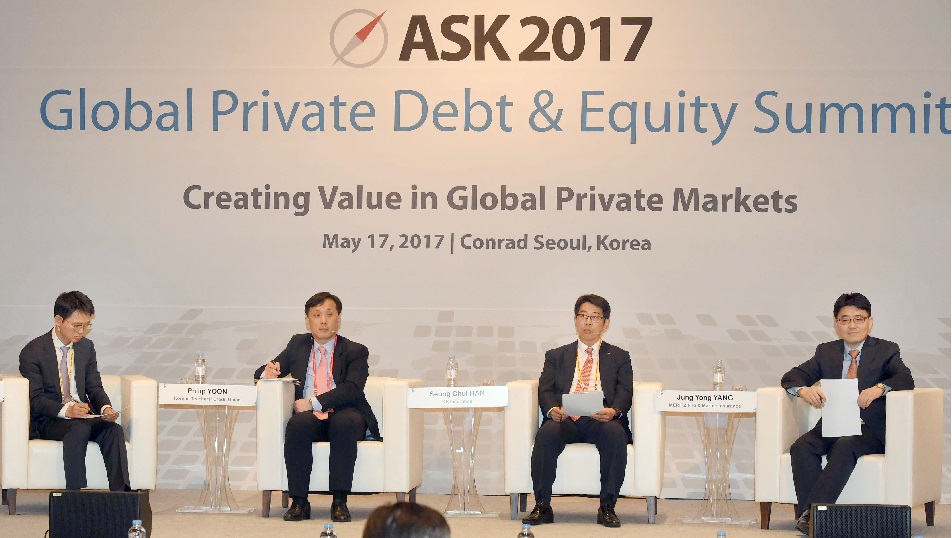[ASK 2017 SUMMIT Panel Talks] Korean insurers seek co-investment, top-tier GPs
May 23, 2017 (Gmt+09:00)
LG Chem to sell water filter business to Glenwood PE for $692 million


Kyobo Life poised to buy Japan’s SBI Group-owned savings bank


KT&G eyes overseas M&A after rejecting activist fund's offer


StockX in merger talks with Naver’s online reseller Kream


Mirae Asset to be named Korea Post’s core real estate fund operator


South Korean insurance companies are looking for co-investment in overseas alternatives with general partners, and leaning towards larger GPs in the increasingly competitive market.
While expanding into a broader range of alternatives, the insurers are keen on longer-dated fixed income-type products so as to extend asset liabilities ahead of the introduction of the accounting standard IFRS 17 in 2021.
They cite regulations such as risk-based capital (RBC) ratios, which require higher capital charges for equity investments than debt, as the biggest hurdle to boosting alternative investments.
The following are remarks from senior officials of three South Korean insurers in panel discussions during the ASK 2017 Private Debt & Equity Summit in Seoul on May 17.

▶Hyundai Marine & Fire Insurance (Kyung Cheol Jeon, a general manager):
“Our committed capital to private debt funds is $200 million. Lending makes up about 50% of the total. We have concentrated in sponsored deals. Non-sponsored deals take more time than sponsored ones to negotiate terms, despite higher profitability. This year we will gradually increase investment (in non-sponsored transactions) after close monitoring.”
“We have also invested in funds of funds which include secondaries, or provide co-investment opportunities. We will focus on co-investment this year.”
“We make a decision with a top-down approach under annual plans, and complete investment on a quarterly basis.”
▶KB Insurance (Seung Chul Han, head of fixed income & equity):
“Our AUM is 23.2 trillion won ($21 billion). Alternatives amount to 6.4 trillion won, or 27.4% of the total: 2.3 trillion won in SOC assets; 1.8 trillion won in structured products; 1.2 trillion won in real estate alternatives; and 800 billion won in private debt.”
“To private equity funds, we have committed 430 billion won domestically and around 400 billion won overseas as of the end of March. We will allocate more money to global blind-pool funds this year, focusing on small caps rather than mega size.”
“Assuming that we invest in private equity within our ceiling, we are wary of high valuations across all asset classes.”
“In the segments we have already invested in, we need to narrow the strike zone and increase the portion for general partners which have low profit volatility. Unless there is a systemic risk such as a financial crisis occurring, it would be good to look for top-tier managers.”
“While maintaining the portions for private debt and private equity, we may seek diversification. Investment in Europe, forex costs of which are low, seems to generate higher risk-adjusted returns.”
▶Meritz Fire & Marine Insurance (Jung Yong Yang, head of asset management):
“Our AUM is 15 trillion won. Our alternative investments are concentrated in domestic real estate, project financing and long-term infrastructure. For overseas alternatives, we focus on longer-dated assets with fixed income characteristics and generating steady cashflows.”
“By asset class, we expanded overseas property investment last year and this year, too. We increased equity investment in class A office buildings in the US and Europe which have blue-chip tenants. This year, we are investing in mezzanine, too.”
“Our investment in aviation financing focused on mezzanine. But this year we are investing in the senior tranche, too. We will diversify into various airlines and airplanes for portfolio diversification.”
“We are taking a cautious approach to global blind-pool funds. Now we are looking at infrastructure debt funds and LBO mezzanine funds.”
“For asset liability management under the IFRS 17, insurance companies need to continue to extend asset durations. So demand for superlong blue-chip debt seems solid. RBC rules keep us pushing aggressively into alternatives.”
“Because of rising dollar hedging costs, insurance companies are attempting to diversify into non-dollar assets. We are setting dynamic strategies for roll-over hedging.”
“Regarding overseas infrastructure, the return gap between top and bottom-performing managers is very wide. It makes track records and AUM size the more important elements.”
“The gap between the returns of infrastructure segments is also wide. For infrastructure, a portfolio-based approach seems easier than individual asset-based approach. LPs will increasingly prefer GPs who can provide co-investment opportunities. With dry powder on the rise, intense competition will likely deepen the divide between fund managers.”
“On hedge funds, considering RBC rules, fixed-income hedge funds look better than equity-type hedge funds. We are trying to invest in them.”
By Daehun Kim and Donghun Lee
daepun@hankyung.com
Yeonhee Kim edited this article
-
 Real estateMirae Asset to be named Korea Post’s core real estate fund operator
Real estateMirae Asset to be named Korea Post’s core real estate fund operatorApr 29, 2025 (Gmt+09:00)
-
 Asset managementMirae Asset bets on China as Korean investors’ US focus draws concern
Asset managementMirae Asset bets on China as Korean investors’ US focus draws concernApr 27, 2025 (Gmt+09:00)
-
 Alternative investmentsMeritz backs half of ex-manager’s $210 mn hedge fund
Alternative investmentsMeritz backs half of ex-manager’s $210 mn hedge fundApr 23, 2025 (Gmt+09:00)
-
 Real estateRitz-Carlton to return to Seoul, tapped by IGIS Asset for landmark project
Real estateRitz-Carlton to return to Seoul, tapped by IGIS Asset for landmark projectApr 22, 2025 (Gmt+09:00)
-
 Real estateS.Korean gaming giant Netmarble eyes headquarters building sale
Real estateS.Korean gaming giant Netmarble eyes headquarters building saleApr 18, 2025 (Gmt+09:00)


